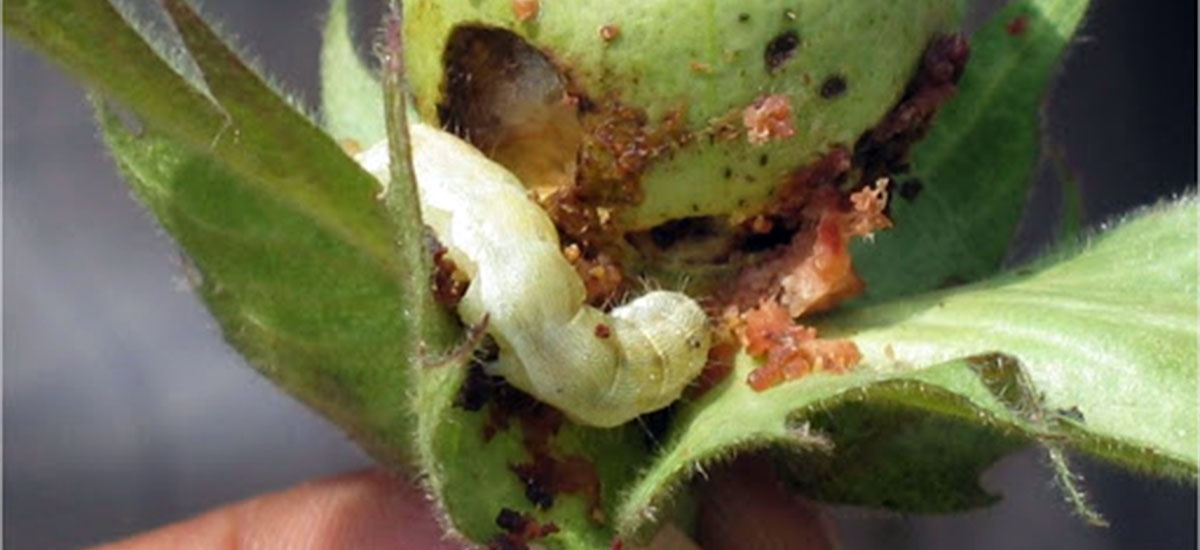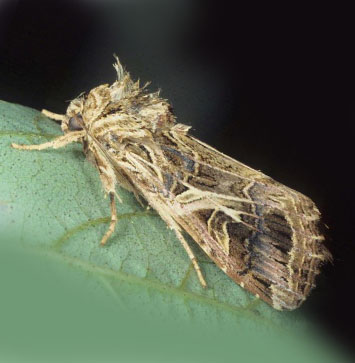
Back>Wheat

Wheat is a staple food crop of Pakistan, dominating all crops in acreage and production. Wheat accounts for 37.1 % of the crop area, 65 % of the food grain acreage, and 70 % of the production. Mainly grown under irrigated conditions, wheats water requirements range from 20-21 in/acre.
Rhopalosiphum padi/R.maidis
سست تیلا
WHEAT
Aphids are green soft bodied insects which have two projections on abdomen called cornicles.

Rhopalosiphum padi/R.maidis
سست تیلا
WHEAT
Rhopalosiphum padi/R.maidis
سست تیلا
WHEAT
Both nymph and adult suck the cell sap from the tender leaves and ears, resulting in lowering of plant vigor and grain formation. They secrete honey dew that stimulates black sooty mold which hinders photosynthesis.

Spodoptera litura
لشکری سنڈی
WHEAT
The armyworm is regarded as a serious pest and can damage and destroy a wide variety of crops, which causes large economic damage.

Spodoptera litura
لشکری سنڈی
WHEAT

Spodoptera litura
لشکری سنڈی
WHEAT
In early stages, larvae feed on tender leaves in central whorl of the plant and in later stages they feed on older leaves. Larvae feed at night from leaf edges towards midrib in a fashion goat have grazed field. They eat voraciously and migrate from one field to another.

Helicoverpa armigera
امریکن سنڈی
WHEAT
There are different names of heliothis wordwide. Heliothis, cotton bollworm, corn earworm, or Old World (African) bollworm (also known as the scarce bordered straw in the UK, where it is a migrant) is a moth, the larvae of which feed on a wide range of plants, including many important cultivated crops. This is an important economic pest round the glob which if left unchecked, can devastate entire cropped area.
.jpg)
Helicoverpa armigera
سامریکن سنڈی
WHEAT

Helicoverpa armigera
امریکن سنڈی
WHEAT
Being as chewing pest larvae feeds on vital parts of plants. Reproductive parts are preferable target but if reproductive parts are not available then they can feed on any plant part. If found on leaves then due to hindrance in photosynthesis heavy yield loss may occur.

Chenopodium album
باتھو
POTATO
Chenopodium album, commonly known as lamb's quarters or white goosefoot, is a fast-growing weed found in fields and gardens. It has diamond-shaped leaves with a powdery coating and inconspicuous flowers that develop into small seeds.

Chenopodium album
باتھو
POTATO
Lamb's quarters can be problematic for farmers as it competes with crops. This resilient weed adapts to diverse conditions and is known for its rapid growth, making it a persistent challenge in agricultural environments.

Chenopodium album
باتھو
POTATO
In most of the crop it causes the yield reduction ranged from 30-60%, but in some cases it can be upto 90% if left uncontrolabale .
Spergula arvensis
کالری بوٹی
Wheat
Spergula arvensis, commonly known as corn spurrey or field sandwort, is an annual herb with slender stems and narrow, opposite leaves. It produces small white flowers with five petals and is often found in fields, gardens, and other disturbed areas.

Spergula arvensis
کالری بوٹی
Wheat
Considered a weed in certain contexts, corn spurrey can be competitive in open spaces. Its ability to thrive in disturbed habitats and produce abundant seeds makes it a challenge for weed control. Effective management strategies are often employed to mitigate its impact on crops and other desirable vegetation.

Spergula arvensis
کالری بوٹی
Wheat
Anagallis arvensis
بلی بوٹی
POTATO
Anagallis arvensis, or scarlet pimpernel, is a low-growing weed often seen in fields. It features small, oval leaves and vibrant scarlet flowers, adding a splash of color to the surroundings.

Anagallis arvensis
بلی بوٹی
POTATO
This weed can be a concern for farmers, as it competes with field crops. Despite its beauty, scarlet pimpernel is adaptable and resilient, making it a persistent issue in agricultural settings.

Anagallis arvensis
بلی بوٹی
POTATO
Euphorbia helioscopia
چھتری ڈوڈک
POTATO
Euphorbia helioscopia, commonly known as sun spurge or madwoman's milk, is an annual herbaceous plant. It has lance-shaped leaves arranged in whorls and produces small, greenish-yellow flowers. The plant contains a milky sap.

Euphorbia helioscopia
چھتری ڈوڈک
POTATO
Considered a weed in agricultural fields and disturbed areas, sun spurge is known for its ability to thrive in various soil conditions. Its milky sap and prolific seed production contribute to its resilience, posing challenges for crop management.

Euphorbia helioscopia
چھتری ڈوڈک
POTATO
Parthenium hysterophorus
گاجر بوٹی
WHEAT
Parthenium hysterophorus, commonly known as parthenium weed or carrot grass, is an annual herb with deeply lobed leaves and small white flowers. It produces large quantities of allergenic pollen and can cause skin irritation.

Parthenium hysterophorus
گاجر بوٹی
WHEAT
Considered a noxious weed, parthenium weed is invasive and competes with native vegetation. It negatively impacts agriculture, displaces desirable plants, and poses health risks due to its allergenic properties. Effective management strategies are employed to control its spread in various regions.

Parthenium hysterophorus
گاجر بوٹی
WHEAT
Parthenium weed in wheat fields may reduce the yield of wheat crop by 14.52% and causes 0.35 ton/ha (3.79 mds/acre) loss to the growers.
Galium aparine
لیپٹی بوٹی / ہوروریہ / WRRI بوٹی
WHEAT
Galium aparine, commonly known as cleavers or stickyweed, is an annual weed with square stems and whorls of narrow, lance-shaped leaves. It produces small, greenish-white flowers and is characterized by tiny hooked hairs that make it cling to surfaces.

Galium aparine
لیپٹی بوٹی / ہوروریہ / WRRI بوٹی
WHEAT
Cleavers are often considered weeds in gardens and agricultural fields. Their ability to cling to surfaces and form tangled masses can be a challenge for crops and desirable plants. Despite being considered a weed, cleavers have been used in traditional medicine for various purposes.

Galium aparine
لیپٹی بوٹی / ہوروریہ / WRRI بوٹی
WHEAT
Wright and Wilson (1987) reported 12–57% losses in grain yield of winter wheat under the infestation of G. aparine. Mennan (1998) observed that infestation of ten G. aparine plants m−2 reduced wheat grain yield by 18%.
Coronopus didymus
جنگلی ہالون / گاجر بوٹی
WHEAT
Coronopus didymus, also known as lesser swinecress, is a low-growing weed with deeply lobed leaves. It produces small clusters of white flowers and is commonly found in fields and disturbed areas.

Coronopus didymus
جنگلی ہالون / گاجر بوٹی
WHEAT
Lesser swinecress can be a nuisance for farmers, as it competes with crops. Its low stature and ability to thrive in various conditions make it a persistent challenge in agricultural landscapes.

Coronopus didymus
جنگلی ہالون / گاجر بوٹی
WHEAT
This weed Cause 75% yield reduction in wheat.
Lathyrus aphaca
جنگلی متار / میٹری
WHEAT
Lathyrus aphaca, commonly known as yellow pea or yellow vetchling, is an annual leguminous plant with pinnate leaves and tendrils. It produces bright yellow flowers and small pods containing seeds.

Lathyrus aphaca
جنگلی متار / میٹری
WHEAT
Yellow pea is often found in fields, meadows, and disturbed areas. While it can be considered a weed in certain situations, its nitrogen-fixing abilities contribute to soil fertility. Additionally, yellow pea has been cultivated for forage and green manure in some agricultural systems.

Lathyrus aphaca
جنگلی متار / میٹری
WHEAT
Rumex dantatus
جنگلی پالک
POTATO
Broadleaf dock usually refers to members of the Rumex genus, particularly Rumex obtusifolius, commonly known as broadleaf dock or bitter dock. It is a perennial weed with large, broad leaves featuring a distinctive elongated shape and prominent veins. The plant produces inconspicuous green flowers on tall spikes.

Rumex dantatus
جنگلی پالک
POTATO
Considered a weed in lawns, gardens, and agricultural fields, broadleaf dock can be persistent due to its deep taproot. Its ability to quickly colonize open spaces and compete with other plants makes it a challenge for weed control in various environments.

Rumex dantatus
جنگلی پالک
POTATO
R. dentatus can reduce wheat yields by 60-70% or more when weed density is high, espically reduce grain yield in wheat
Chenopodium murale
کرنڈ
Wheat
Chenopodium murale, or nettle-leaved goosefoot, is a weed commonly found in fields and disturbed areas. It features lance-shaped leaves with serrated edges and inconspicuous flowers that lead to the formation of small, round seeds.

Chenopodium murale
کرنڈ
Wheat
This weed is a challenge for farmers because it thrives in dry and disturbed areas, making it troublesome for field crops. Its ability to adapt and persist makes it a persistent problem in agricultural settings.

Chenopodium murale
کرنڈ
WHEAT
It can reduce the yield from 30 to 60 % in crops based on Density of plants
Convulvulus arvensis
لیہلی
WHEAT
Convolvulus arvensis, or field bindweed, is a persistent weed with twining stems and arrow-shaped leaves. It produces attractive white to pink trumpet-shaped flowers and forms extensive root systems, making it challenging to control.

Convulvulus arvensis
لیہلی
Wheat
Field bindweed is a troublesome weed in agricultural settings, competing with crops and often reducing yields. Its ability to spread through its extensive roots makes it a persistent and difficult-to-manage problem for farmers.

Helicoverpa armigera
امریکن سنڈی
Wheat
C. arvensis can reduce yields by up to 67% in extreme cases, as the influx of weeds, including C. arvensis, can reduce yields by 25-30% if not properly controlled
Vicia sativa
ریواری
Wheat
Vicia sativa, commonly known as common vetch or spring vetch, is an annual or biennial leguminous plant. It has pinnate leaves and produces clusters of small, pea-like flowers in various colors, including purple, pink, or white. The plant is often found in fields, meadows, and disturbed areas.

Vicia sativa
ریواری
Wheat
Common vetch is valued for its nitrogen-fixing properties, which contribute to soil fertility. While it can be considered a weed in certain contexts, it is also cultivated as a forage crop and cover crop. Its ability to improve soil health and provide forage for livestock makes it a beneficial plant in agricultural systems.

Vicia sativa
ریواری
Wheat
As the influx of weeds, including V. sativa, can reduce yields by 45 to 60% if not properly controlled, with pulses like chickpea, lentil, and field pea experiencing losses ranging from 20 to 77%
Vicia sativa
ریواری
Wheat
Medicago denticulata, commonly known as toothed medick, is an annual or biennial leguminous plant. It has pinnate leaves with toothed leaflets and produces small yellow flowers arranged in compact clusters. The plant forms spiral seed pods.

Vicia sativa
ریواری
Wheat
Toothed medick is often found in disturbed areas, fields, and along roadsides. While it can be considered a weed in certain contexts, it has nitrogen-fixing properties that contribute to soil fertility. Additionally, it provides forage for livestock in some regions.

Vicia sativa
ریواری
Wheat
As the influx of weeds, including V. sativa, can reduce yields by 45 to 60% if not properly controlled, with pulses like chickpea, lentil, and field pea experiencing losses ranging from 20 to 77%
















